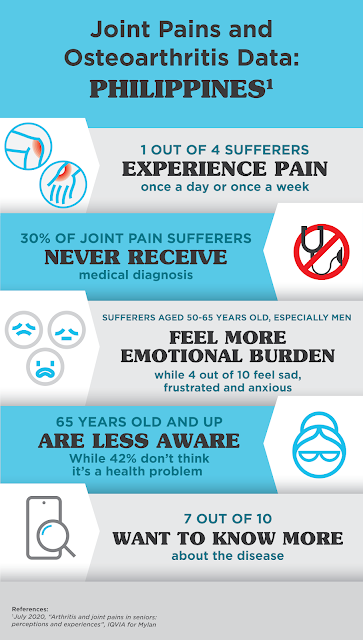Local IQVIA 2020 survey for Mylan, a Viatris Company, shows how joint pain and osteoarthritis affect Filipinos both physically and emotionally
In the Philippines, around 4.2 million people suffer from osteoarthritis, a condition characterized by joint pain which can limit daily activities like walking. Osteoarthritis (OA) is a chronic disease that primarily affects the cartilage, structures that protect the ends of bones within the joints.
Joint pain and osteoarthritis affect more people, and in more ways, that we might realize. As more and more Filipinos are finding it difficult to seek medical advice during this time of uncertainty, it’s important to educate the public about joint pain and osteoarthritis, as well as the potential consequences of delayed treatment.
Filipinos suffering from joint pain have an average age of 61 years, and 1 out of 4 experience joint pain often, at least once a week, sometimes even daily, especially in the hands and knees. There are different attitudes towards the disease based on age. The elderly who are over 65 seem more resigned and indifferent, while younger sufferers at 50-65 years old are more aware and reactive.
42% of elderly respondents consider joint pain a minor or nonexistent health problem. In contrast, around 6 out of 10 sufferers aged 50 to 64 years old are aware that the condition of their cartilages may worsen with age and believe that joint pain is more than a health problem.
These are the main findings from a national survey conducted in Philippines by IQVIA for Mylan, a Viatris company, to investigate the experiences, perceptions and needs of people with joint pain and osteoarthritis.
THE BURDEN OF DISEASE
In general, about half of the respondents have problems managing the disease emotionally and physically. Sufferers aged 50-65 years old, especially men, feel the emotional burden of the disease more, with almost 4 out of 10 expressing not just feelings of sadness, but also frustration and anxiety. Elderly patients seem to feel the emotional effects of the disease less, with only 2 out of 10 of them
expressing sadness.
DIAGNOSIS AND TREATMENT
The survey clearly shows that a large proportion of Filipino respondents never consult a doctor for joint pain. Overall, around 30% of sufferers – 42% among those aged 50-65 years old – say that they have never received a medical diagnosis for their joint related symptoms. In addition, among those who have received a diagnosis, only 1 out of 2 were examined by a specialist, the rest consulted a general practitioner or a pharmacist.
THE NEED FOR MORE INFORMATION
Filipinos lack awareness on osteoarthritis disease and available treatments. Almost 7 out of 10 respondents declare that they wish to know more about it, especially those aged 50-65.
In order to get more information about OA, half of Filipino patients rely on family and friends or on internet, a trend that is growing more and more among the 50 to 65-year-olds – the category most reluctant to see HCPs. in fact, 77% of them uses online search engines as their primary source.
“At Viatris, we find the results of this research to be both insightful and useful. We are committed to providing support to Filipino doctors and other health care professionals in order to find, together, a way not only to better manage osteoarticular disease, but to also spread health information with the goal of
improving the public’s awareness.
Studies have shown that prescription of crystalline glucosamine sulfate has the triple effect of reducing joint pain, improving physical function and delay the progression of osteoarthritis.




